September 25, 1922 – First New Mexico Oil Well –
Midwest Refining Company launched the New Mexico petroleum industry by completing the state’s first commercial oil well. Drilled near Shiprock on the Navajo Indian Reservation, the Hogback No. 1 well produced 375 barrels of oil per day.
Following the oilfield discovery, Midwest successfully completed 11 more wells to establish the Hogback field as a major producer of the San Juan Basin. Two years later, a pipeline was built to Farmington, where oil was shipped by rail to refineries in Salt Lake City, Utah.
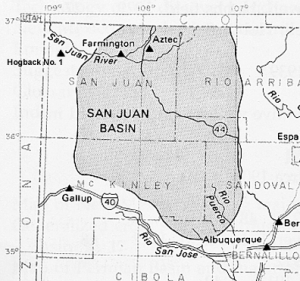
Midwest Refining Company discovered the Hogback oilfield in New Mexico’s San Juan Basin.
Production from the Hogback oilfield encouraged further exploration in New Mexico, leading to discoveries in 1928 at Hobbs in Lea County.
Learn more in First New Mexico Oil Wells.
September 26, 1876 – First Commercial California Oil Well
After three failed attempts, Charles Mentry’s California Star Oil Works Company discovered the Pico Canyon oilfield north of Los Angeles — California’s first commercial oil well. Drilled in a region known for natural oil seeps, the Pico No. 4 well produced 25 barrels of oil per day from a depth of 370 feet.
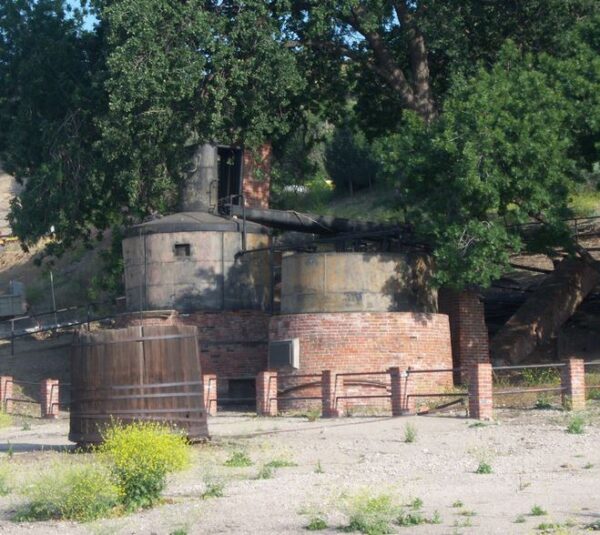
Preserved by the Santa Clarita Valley Historical Society, California’s first refinery is described as the oldest in the world. Photo courtesy Konrad Summers.
Pico Canyon oilfield production would lead to construction of California’s first oil pipeline and the state’s first commercially successful oil refinery for making kerosene lamp fuel and lubricants. Riveted stills set on brick foundations had a refining capacity of 150 barrels of oil a day.
California Star Oil Works was acquired by Pacific Coast Oil Company in 1879, and the Pico Canyon oilfield discoverer became part of the Standard Oil Company of California (Socal) in 1906. Socal acquired Gulf Oil, the nation’s fifth-largest petroleum company at the time, in 1984 and adopted the brand name Chevron.
Learn more in First California Oil Wells.
September 26, 1933 – King Ranch Lease sets Record
Despite the reservations of Humble Oil and Refining Company’s president, geologist Wallace Pratt convinced the company to lease the almost million-acre King Ranch in Texas for almost $128,000 per year with a one-eighth royalty on any discovered oil.
Although Humble Oil and Refining, a Houston company founded in 1917, had not found oil on the ranch, the lease deal was the largest oil lease contract ever negotiated in the United States.
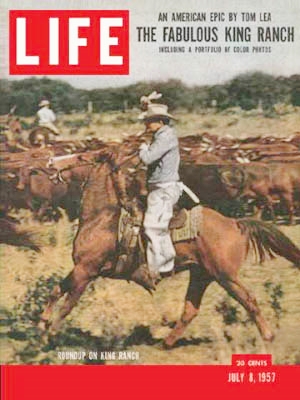
A 1933 King Ranch oil lease set a record.
Subsequent leases on nearby ranches gave Humble Oil & Refining nearly two million acres of mineral rights between Corpus Christi and the Rio Grande River.
By 1947, Humble operated 390 producing oil wells on the King Ranch lease alone. The company became ExxonMobil, which has regularly extended its 1933 King Ranch lease agreement.
Learn more in Oil Reigns at King Ranch.
September 26, 1943 – First Florida Oil Well
Near a watering stop on the Atlantic Coast Line Railroad in southwestern Florida, the Humble Oil and Refining Company completed the state’s first commercial oil well, the Sunniland No. 1. The company had spent $1 million drilling to a depth of about 11,600 feet to complete the discovery well, located 12 miles south of Immokalee, near Big Cypress Preserve and the resort city of Naples.

Humble Oil and Refining Company donated $60,000 to the University of Florida and the Florida State College for Women.
Florida’s petroleum had eluded discovery for decades. Almost 80 dry holes had been drilled by 1939. and Florida legislators, eager for their state to benefit from oil tax revenues, offered a $50,000 bounty for the first oil discovery. The Sunniland oilfield brought more drilling, and by 1954 the field was producing 500,000 barrels of oil per year from 11 wells.
Texas-based Humble Oil accepted the $50,000 prize offered by the state legislature, added $10,000 – and donated the $60,000 equally between the University of Florida and the Florida State College for Women. Humble later became ExxonMobil.
Learn more in First Florida Oil Well.
September 27, 1915 – Deadly Explosion in Ardmore, Oklahoma
A railroad car carrying casinghead gasoline exploded in Ardmore, Oklahoma, killing 43 people and injuring others. The car, which had arrived the day before, was waiting to be taken to a nearby refinery. Casinghead gasoline (also called natural gasoline) at the time was integral to the state’s petroleum development, with 40 processing plants in operation.
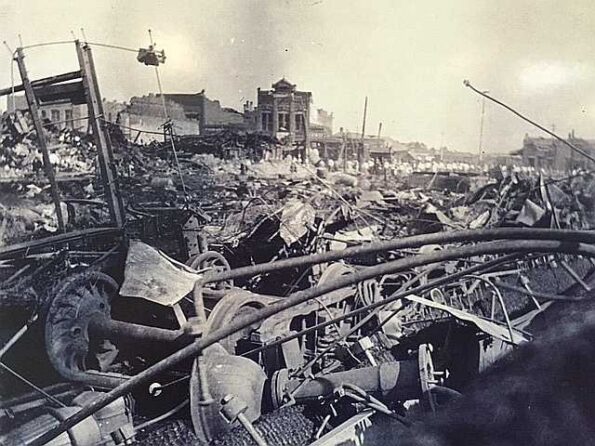
A casing gas explosion destroyed most of downtown Ardmore, Oklahoma, in 1915. Photo courtesy Oklahoma Historical Society.
According to the Oklahoma Historical Society (OHS), the disaster began when rising afternoon temperatures activated a valve to release the car’s gas pressure. “The Ardmore Refining Company then sent a representative, who removed the dome from the top of the car, filling the air with gas and vapors.”
Triggered by an unidentified source, the explosion destroyed much of downtown Ardmore. The Atchison, Topeka, & Santa Fe Railway was found responsible for the explosion and paid 1,700 claims totaling $1.25 million, OHS reported, adding, “Oil companies changed and improved the extraction and transportation methods for natural gasoline.”
September 28, 1945 – Truman claims America’s Outer Continental Shelf
President Harry Truman extended U.S. jurisdiction over the natural resources of the outer continental shelf, placing them under the control of the Secretary of the Interior. In August 1953, Truman’s edict would become the Outer Continental Shelf Lands Act, which affirmed exclusive jurisdiction over U.S. continental shelf and a federal leasing program, “to encourage discovery and development of oil.”
The earliest U.S. offshore wells were drilled on lakes; learn more in Offshore Oil & Gas History articles.
September 30, 2006 – Bronze Roughnecks dedicated at Signal Hill, California
A “Tribute to the Roughnecks” statue by Cindy Jackson was dedicated near the Alamitos No. 1 well, which in 1921 revealed California’s prolific Long Beach oilfield 20 miles south of Los Angeles.

Signal Hill once had so many derricks people called it Porcupine Hill. The city of Long Beach is visible in the distance from the “Tribute to the Roughnecks” statue by Cindy Jackson.
The bronze statue commemorates the Signal Hill Oil Boom. A plaque notes the monument serves, “as a tribute to the petroleum pioneers for their success here, a success which has, by aiding in the growth and expansion of the petroleum industry, contributed so much to the welfare of mankind.”
October 1, 1908 – Ford Motor Company produces First Model T
The first production Ford Model T rolled off the assembly line at the company’s plant in Detroit. Between 1908 and 1927, Ford would build about 15 million Model Ts, each fueled by inexpensive gasoline. The popularity of Ford’s auto was timely for the U.S. oil industry, which had endured falling demand for kerosene lamp fuel as consumers switched to electric lighting.
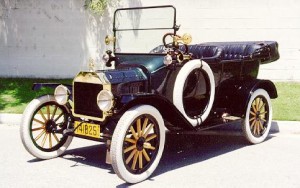
Ford Model T tires were white until 1910, when the petroleum product carbon black was added to improve durability.
New major oilfield discoveries, especially the 1901 “Lucas Gusher” at Spindletop Hill near Beaumont, Texas, met growing demand for what had been a refining byproduct: gasoline.
Learn more early U.S. automobile history in Cantankerous Combustion – 1st U.S. Auto Show.
October 1, 1942 – Water Injection Project begins in East Texas
The East Texas Salt Water Disposal Company drilled the first salt water injection well in the 12-year-old East Texas oilfield near the towns of Tyler, Longview, and Kilgore. As early as 1929, the Federal Bureau of Mines had determined injecting recovered saltwater into formations could increase reservoir pressures and oil production.
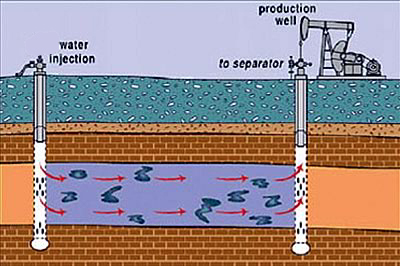
Saltwater injection wells improved oil production in the giant East Texas oilfield.
The Texas Railroad Commission established the salt water disposal company as a public utility to operate in the “Black Giant” oilfield. The company treated and re-injected about 1.5 billion barrels of saltwater in its first 13 years, prompting the commission to proclaim saltwater injection as the “greatest oil conservation project in history.”
______________________
Recommended Reading: Oil in West Texas and New Mexico (1982); Black Gold in California: The Story of California Petroleum Industry
(2016); Kings of Texas: The 150-Year Saga of an American Ranching Empire
(2003); Oil in the Deep South: A History of the Oil Business in Mississippi, Alabama, and Florida, 1859-1945
(1993); Signal Hill, California, Images of America
(2006); From Here to Obscurity: An Illustrated History of the Model T Ford, 1909 – 1927
(1971); Wildcatters: Texas Independent Oilmen
(1984). Your Amazon purchase benefits the American Oil & Gas Historical Society. As an Amazon Associate, AOGHS earns a commission from qualifying purchases.
_______________________
The American Oil & Gas Historical Society (AOGHS) preserves U.S. petroleum history. Become an AOGHS annual supporting member and help maintain this energy education website and expand historical research. For more information, contact bawells@aoghs.org. Copyright © 2023 Bruce A. Wells. All rights reserved.


